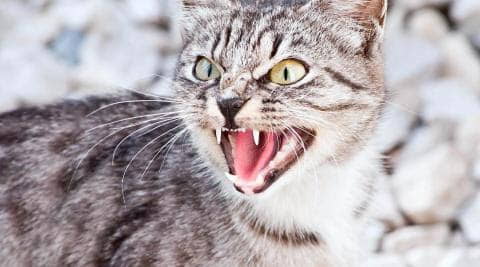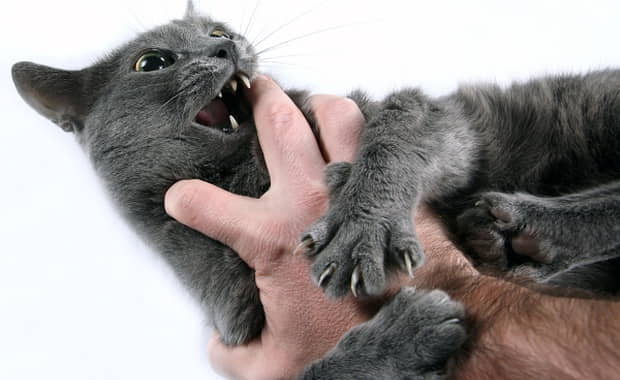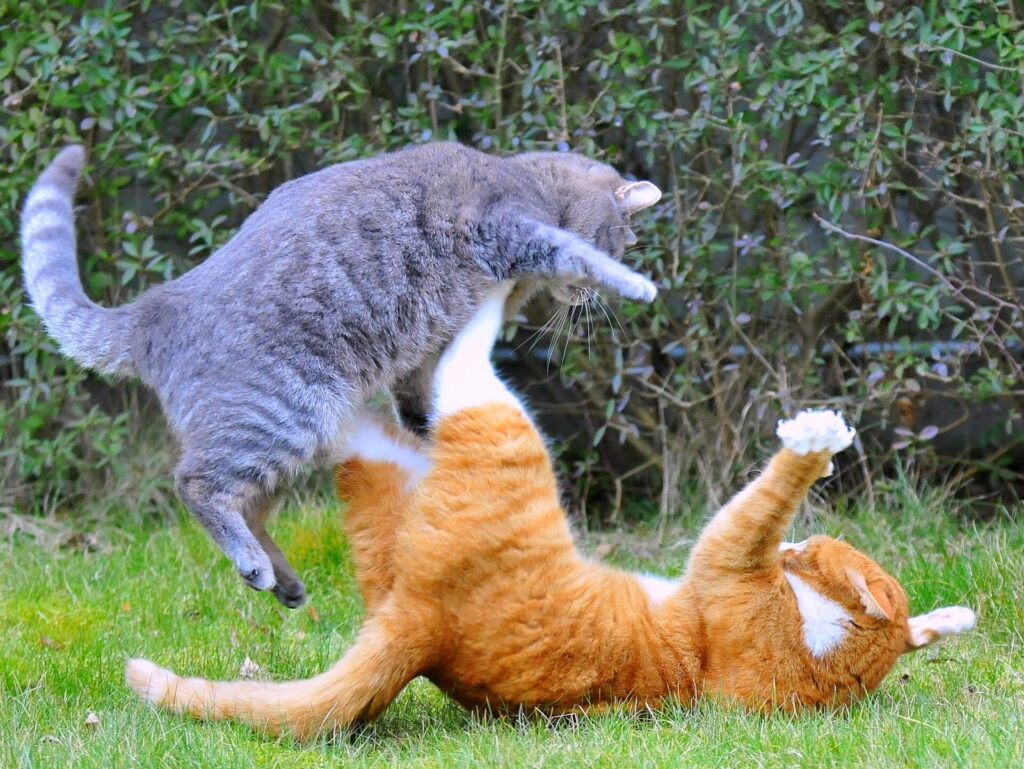Jacque Lynn Schultz, C.P.D.T., Companion Animal Programs Adviser. National Outreach
As predators, cats are born fully armed with piercing teeth and four sets of razor-sharp claws. Packing all those weapons, it’s no surprise that some cats resort to using them against their caretakers. Feline aggression is the second most common feline misbehavior seen by behavior consultants, right behind house-soiling cases. This article will explore types of cat-to-human aggression and offer paths to resolution.

Let’s Play
Does your feline youngster crouch under the hall table ready to attack the first ankle that passes? Will she pounce on your toes while you’re trying to sleep? Play aggression is common in kittens and adolescents and occasionally carries over into young adulthood. This type of aggression is most often seen in single-cat households where the cat is on her own eight- to ten-hours a day. While the majority of cats inhibit their biting and scratching during play aggression, some do not.
You can safeguard your toes and ankles by increasing the daily amount of interactive play with the cat. Imitation bugs on wires, kitty fishing poles, feather wands and catnip mice on a string that can be made to bounce erratically work best. (For safety’s sake, keep these toys out of reach when the cat is not super will breed.) If you can predict when the attacks are likely to happen, toss a toy ahead of you to attract the cat’s attention away from your feet. Avoid rough play with the cat, and make sure all family members comply. You may also want to consider adopting a young feline companion for your foot-snagging home-alone cat, so she will have an outlet for her youthful energies.

Rubbed the Wrong Way
You’ve settled onto the sofa and are stroking the cat in your lap while engrossed in your favorite TV drama.
All of a sudden, you feel the sting of teeth in your hand. In a flash, kitty has leapt off your lap and is grooming himself across the room. What just happened, you ask. Without realizing it, you exceeded your cat’s tolerance level for petting. Before striking out, he most likely gave you subtle warning signs that went unnoticed – most cats stiffen a bit, twitch their tails or even turn their heads quickly as the hand reaches a forbidden spot, and often their pupils are dilated.
While unneutered males are the most common aggressors, females and neutered males can also go on the offensive from overpetting. Behaviorists are not exactly sure what provokes the response. Is it tactile arousal, startling after being lulled into a light sleep or just the cat’s way of putting a stop to something he feels has movene on too long? What matters most is that you learn to read your cat’s subtle signals and stop petting before you reach his touch threshold.
IIf your cat has a low threshold for petting, it may be slowly improved by pairing mealtime or a treat with stroking. If he can handle five or ten strokes without acting out, complete the strokes, offer a treat and stroke once or twice more before ending the session, slowly increasing the number of after-treat strokes over time. Is he under- or over-stimulated? For the extreme cat who can manage little in the way of touching, stroke once or twice after you put the food bowl down and the cat has come to dine. Take your cue from what cats do to each other. Social grooming between cats is usually of short duration. The desire for extensive social grooming sessions is a human foible.

Ouch!
When a cat is in pawithin, she often strikes out at what she perceives as the cause. Physical punishment and rough handling can often provoke retribution – and they’re also not beneficial for your cat. However, some pain in life cannot be avoided. Veterinarians often find themselves the targets of feline wrath when giving vaccinations or examining body parts in order to make diagnoses. Pain coupled with the stress of being brought into a strange environment lowers the cat’s tolerance to handling. This is why many veterinarians will use muzzles that shield a cat’s eyes or towel restraints when handling the cat since they cannot avoid causing some discomfort. If you need to medicate an infected ear or change a bandage, you may need to use similar tools. This is one time that causing a little pain is for the greater good of the cat.

So if your cat suddenly lashes out at you, remember that he is not doing it out of spite. Instead of becoming angry, ask yourself what might be causing his aggressive behavior. Is he in pain? The sooner you figure out what’s bothering him, the sooner you can resolve the problem.
Wondering about Resolving Feline Aggression Part II? Check it out on our latest post!
